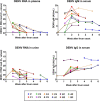Autochthonous dengue outbreak in Italy 2020: clinical, virological and entomological findings
- PMID: 34409443
- PMCID: PMC8499737
- DOI: 10.1093/jtm/taab130
Autochthonous dengue outbreak in Italy 2020: clinical, virological and entomological findings
Abstract
Background: In August 2020, in the context of COVID-19 pandemics, an autochthonous dengue outbreak was identified for the first time in Italy.
Methods: Following the reporting of the index case of autochthonous dengue, epidemiological investigation, vector control and substances of human origin safety measures were immediately activated, according to the national arbovirus surveillance plan. Dengue cases were followed-up with weekly visits and laboratory tests until recovery and clearance of viral RNA from blood.
Results: The primary dengue case was identified in a young woman, who developed fever after returning from Indonesia to northern Italy, on 27 July 2020. She spent the mandatory quarantine for COVID-19 at home with relatives, six of whom developed dengue within two weeks. Epidemiological investigation identified further five autochthonous dengue cases among people who lived or stayed near the residence of the primary case. The last case of the outbreak developed fever on 29 September 2020. Dengue cases had a mild febrile illness, except one with persistent asthenia and myalgia. DENV-1 RNA was detected in blood and/or urine in all autochthonous cases, up to 35 days after fever onset. All cases developed IgM and IgG antibodies which cross-reacted with West Nile virus (WNV) and other flaviviruses. Sequencing of the full viral genome from blood samples showed over 99% nucleotide identity with DENV-1 strains isolated in China in 2014-2015; phylogenetic analysis classified the virus within Genotype I. Entomological site inspection identified a high density of Aedes albopictus mosquitoes, which conceivably sustained local DENV-1 transmission. Aedes koreicus mosquitoes were also collected in the site.
Conclusions: Areas in Europe with high density of Aedes mosquitoes should be considered at risk for dengue transmission. The presence of endemic flaviviruses, such as WNV, might pose problems in the laboratory diagnosis.
Keywords: Aedes albopictus; Aedes koreicus; DENV; follow-up; saliva; surveillance; urine.
© The Author(s) 2021. Published by Oxford University Press on behalf of International Society of Travel Medicine.
Figures



References
-
- Barzon L. Ongoing and emerging arbovirus threats in Europe. J Clin Virol 2018; 107:38–47. - PubMed
Publication types
MeSH terms
Grants and funding
LinkOut - more resources
Full Text Sources
Other Literature Sources
Medical

